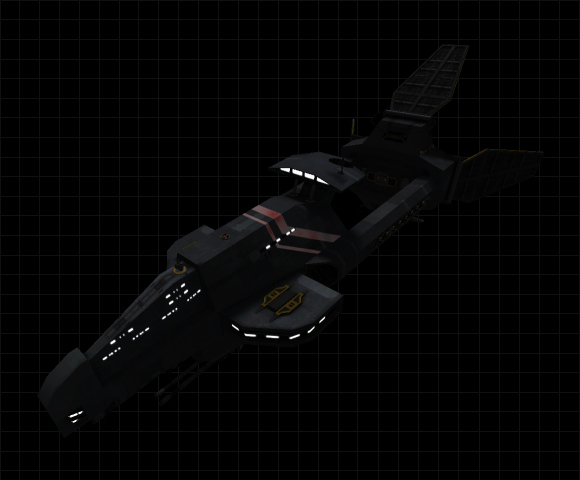Difference between revisions of "GTFg Jupiter(Frontlines)"
Black Wolf (talk | contribs) (Created page with '{{FLShips|image=Image:FLJupiter.jpg|tech=The Jupiter class frigate was originally designed to support the Fenris class cruisers. Although almost as long as its larger cousin,…') |
Black Wolf (talk | contribs) |
||
| Line 1: | Line 1: | ||
| − | {{FLShips|image=[[Image:FLJupiter.jpg]]|tech= | + | {{FLShips|image=[[Image:FLJupiter.jpg]]|tech=With well over a decade of active service to date, the Jupiter class frigate represents the apex of a previous generation of shipbuilding philosophy and technology within the Galactic Terran Alliance. Until the development of the Fenris cruiser, the Jupiter was the most powerful ship in the fleet, and even today, its twin forward railguns and heavy missiles make it a threat to any Vasudan ship it may encounter. |
| + | |||
| + | The primary mission of the Jupiter has always been long-range patrol, and its armament and design reflect that fact. It carries consumables for months of operation without restocking, and can adequately defend itself against threats both large and small. However, it small hangar, and complement of Comet class shuttles and Leto-I interceptors, grant the Jupiter enormous tactical flexibility, and Jupiters are therefore called on to perform a wide array of tasks in the modern fleet, including search and rescue, fleet support, high priority intersystem transportation | ||
| + | |||
| + | As valuable – indeed, essential – as these vessels are to the Terran fleet, there is no denying that the c lass is showing its age. Its engines are a generation behind modern standards, and must emit an unacceptably high level of dangerous radiation to move the massive frame of the Jupiter, necessitating their positioning far back from inhabited parts of the ship. Thus, while the Jupiter is significantly longer than a Fenris, available internal space is broadly comparable, and habitable internal space is significantly lower. Combined with the need to store ammunition for an entirely projectile based armament, supplies for several months of independent operations, and a small fighter wing, space for the crew is extremely limited, and service aboard a Jupiter is considered far more challenging than service on almost any other class of vessel. | ||
| + | |||
| + | To address these problems, fleet command is planning an extensive refit to bring the Jupiters up to modern standards. But with the first tranche of these refits not scheduled until mid next year, it expected that the current iteration of the Jupiter will be remaining in service for the immediate future.}} | ||
Latest revision as of 15:05, 31 March 2017
With well over a decade of active service to date, the Jupiter class frigate represents the apex of a previous generation of shipbuilding philosophy and technology within the Galactic Terran Alliance. Until the development of the Fenris cruiser, the Jupiter was the most powerful ship in the fleet, and even today, its twin forward railguns and heavy missiles make it a threat to any Vasudan ship it may encounter.
The primary mission of the Jupiter has always been long-range patrol, and its armament and design reflect that fact. It carries consumables for months of operation without restocking, and can adequately defend itself against threats both large and small. However, it small hangar, and complement of Comet class shuttles and Leto-I interceptors, grant the Jupiter enormous tactical flexibility, and Jupiters are therefore called on to perform a wide array of tasks in the modern fleet, including search and rescue, fleet support, high priority intersystem transportation As valuable – indeed, essential – as these vessels are to the Terran fleet, there is no denying that the c lass is showing its age. Its engines are a generation behind modern standards, and must emit an unacceptably high level of dangerous radiation to move the massive frame of the Jupiter, necessitating their positioning far back from inhabited parts of the ship. Thus, while the Jupiter is significantly longer than a Fenris, available internal space is broadly comparable, and habitable internal space is significantly lower. Combined with the need to store ammunition for an entirely projectile based armament, supplies for several months of independent operations, and a small fighter wing, space for the crew is extremely limited, and service aboard a Jupiter is considered far more challenging than service on almost any other class of vessel. To address these problems, fleet command is planning an extensive refit to bring the Jupiters up to modern standards. But with the first tranche of these refits not scheduled until mid next year, it expected that the current iteration of the Jupiter will be remaining in service for the immediate future. |



